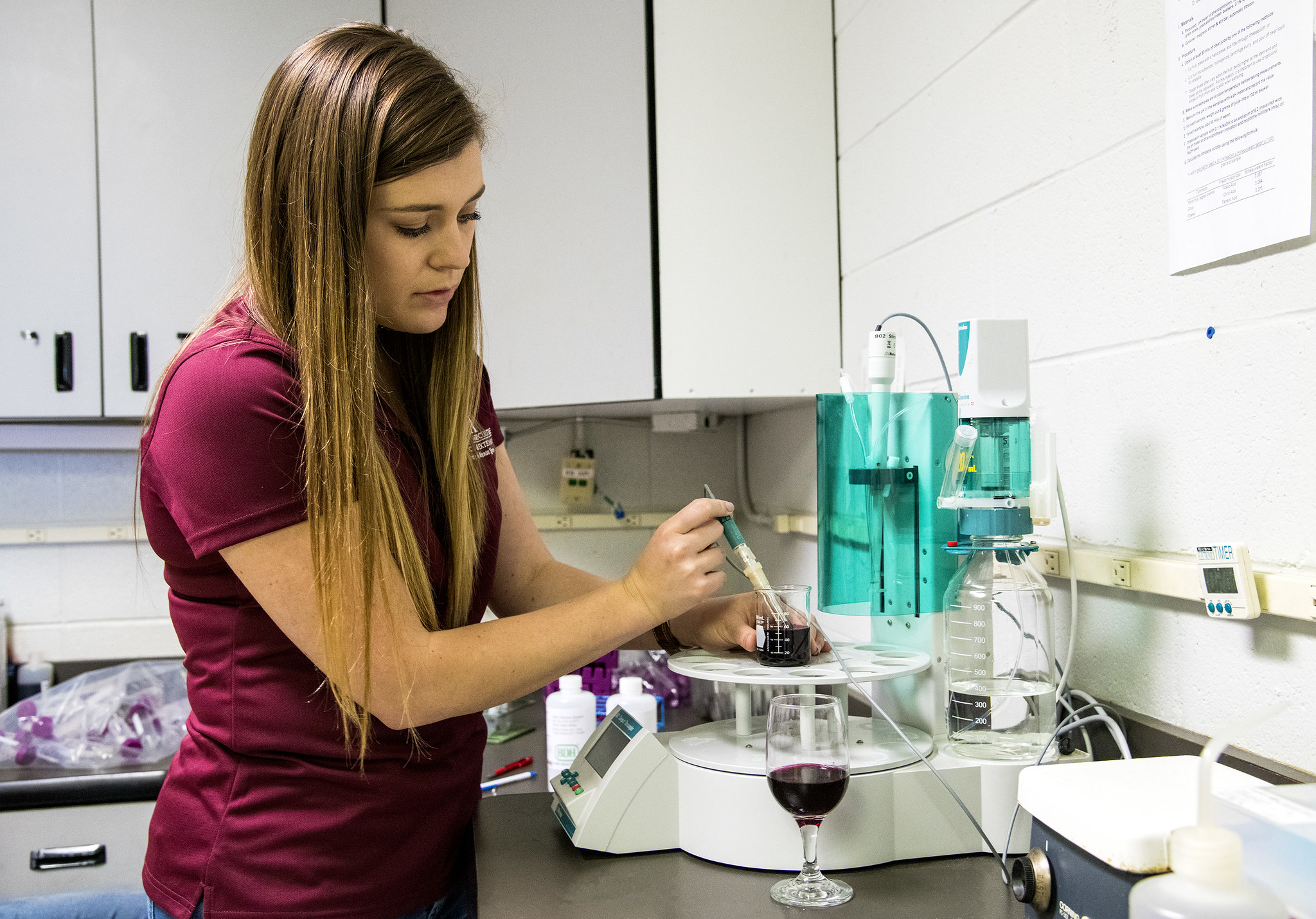Division of Ag researchers work to improve wine made with Arkansas grapes
By Abbi Ross
U of A System Division of Agriculture
@AgNews479
Fast Facts:
- Division of Agriculture research to focus on improved wines from its varieties
- Ph.D.student Sarah Mayfield earned three national awards for enology and viticulture
(539 words)
Newsrooms: with art here: https://flic.kr/s/aHsmEgno5N
FAYETTEVILLE, Ark. – Arkansas’s climate is tough on grapes destined for wine, but what may be tougher is finding the right style to turn those grapes into ones that will delight both the nose and palate.

Renee Threlfall, a research scientist in the Food Science Department for the University of Arkansas System Division of Agriculture, is working on several projects with Arkansas wine grapes including the first two wine grapes released by the Division of Agriculture fruit breeding program in 2016.
Enchantment, a red wine grape and Opportunity, a white wine grape took decades, but John Clark, distinguished professor and Division of Agriculture fruit breeder, released them as the division’s first Arkansas-focused wine grapes. (See: https://www.uaex.uada.edu/media-resources/news/november2016/11-10-2016-Ark-Long-Grape-Journey.aspx)
Sarah Mayfield, Threlfall’s graduate student, is working on her Ph.D. in food science at the University of Arkansas’s Dale Bumpers College of Agricultural, Food and Life Sciences, Mayfield began working with Threlfall two years ago, she said.
Mayfield’s research is focused on the “Physicochemical Properties of Wines Produced from Grapes Grown in Arkansas,” which includes studying “Enchantment grapes and wine-making potential,” said Threlfall, adding that they will be identifying “how to highlight and enhance unique flavors and aromas” in the wines made from Enchantment.
“We are also evaluating Opportunity and two other potential white wine grapes for release from the breeding program,” Threlfall said. As new grape cultivars are released it is important to know what winemaking styles such as skin contact time, yeast type, or oak and tannin additions, to use for production.
Mayfield is also working on Chambourcin, a French-American hybrid red wine grape cultivar. The project is unique because it encompasses the entire scope of working with the grapes in the vineyard all the way to making wine for consumer evaluations, Threlfall said.
Using industry-sponsored funds, the research team is working with Lynn Gay, Hindsville Farm in Hindsville, Arkansas, to evaluate the use of inactive dried yeast application to grapevines on quality of Chambourcin grapes and wine.
The spray is commercially used and believed to enhance quality, but there is not a lot of research on the product use, Mayfield said.
“For the Chambourcin project, we are evaluating the use of LalVigne®, which is an inactivated dry yeast that is rehydrated and sprayed onto grapevines in the vineyard as they begin to ripen,” Mayfield said.
As wine ferments, the yeast cells gradually settle to the bottom of the fermentation vessel. This sediment can be recovered, dried, added to water, and sprayed on grapevines, Mayfield said.
“We are evaluating how it affects the grapes themselves during ripening, harvesting grapes to make wine, and then evaluating physicochemical and aroma properties of the wines and then doing sensory evaluations to determine if consumers can perceive color, aroma, or flavor differences in the wines due to LalVigne®application,” Mayfield said.
Mayfield recently earned three national scholarships in the grape and wine industry:
American Society for Enology and Viticulture, or ASEV, Presidents’ Award for scholarship in Enology, American Wine Society Educational Foundation scholarship and the ASEV-Eastern Section scholarship.
“This is the first time that a University Arkansas student has received all three awards!” Threlfall said. “These organizations award scholarships to graduate students pursuing a degree in enology, viticulture, or a curriculum emphasizing a science basic to the wine and grape industry.”
To learn more about Division of Agriculture research, visit the Arkansas Agricultural Experiment Station website: https://aaes.uark.edu. Follow us on Twitter at @ArkAgResearchand Instagram at ArkAgResearch.
About the Division of Agriculture
The University of Arkansas System Division of Agriculture’s mission is to strengthen agriculture, communities, and families by connecting trusted research to the adoption of best practices. Through the Agricultural Experiment Station and the Cooperative Extension Service, the Division of Agriculture conducts research and extension work within the nation’s historic land grant education system.
The Division of Agriculture is one of 20 entities within the University of Arkansas System. It has offices in all 75 counties in Arkansas and faculty on five system campuses.
Pursuant to 7 CFR § 15.3, the University of Arkansas System Division of Agriculture offers all its Extension and Research programs and services (including employment) without regard to race, color, sex, national origin, religion, age, disability, marital or veteran status, genetic information, sexual preference, pregnancy or any other legally protected status, and is an equal opportunity institution.
Media Contact: Mary Hightower
Dir. of Communication Services
U of A Division of Agriculture
Cooperative Extension Service
(501) 671-2126
mhightower@uada.edu
Related Links